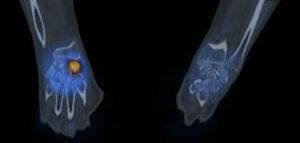TOLL FREE:
1-866-611-2665

Home WRIST FRACTURES: COMMON INJURIES FROM A FALL
In Canada, many of us are wary of when the snow starts to fall and the ground gets icy, especially if you are one of the many people who have been injured in a fall. According to the Canadian Institute for Health Information, four out of five injury hospitalizations involving seniors were due to falls. From 2016-2019, injury hospitalizations among seniors due to falls increased by 9%.
Cold weather can also make muscles and ligaments cold and tight, increasing the propensity for injury in all age groups. One of the most common injuries occurs when you try to break your fall with your hands, often resulting in a wrist fracture.
The wrist is made up of eight small bones which connect with the two long forearm bones called the radius and ulna. Although a broken wrist can happen in any of these 10 bones, by far the most common bone to break is the radius – called a distal radius fracture. The scaphoid bone, one of the small wrist bones, can also be commonly fractured after such a fall. Bone diseases like osteoporosis can also increase the likelihood of a fracture.
With a distal radius fracture, there is often pain, swelling, or difficulty moving or using the hand and wrist. A bone out of place can make the wrist appear deformed and sometimes the fingers tingle or feel numb at the tips.
Symptoms of a scaphoid fracture typically include pain and tenderness in the area just below the base of the thumb, which may worsen when you try to pinch or grasp something. However, unless you or your doctor sees a visible deformation of your wrist, it might not be obvious that your scaphoid bone is broken. Sometimes, the pain is mild and may be mistaken for a wrist sprain.
Seeing a physician after such a fall is important in helping to avoid potential complications of a fracture, such as the bone not healing, disrupted blood supply to the bone, or development of early arthritis.
Depending on the type of fracture, wrist injuries can be treated with splints or casts. In more serious or complex breaks, surgery may be required to correctly position and stabilize damaged bones.
Treatment for a scaphoid fracture can range from casting to surgery, depending on the fracture’s severity and location in the bone. That’s why it’s important to accurately diagnose and localize the fracture.
Depending on your symptoms, your doctor may send you for an X-ray to determine if there are any fractured bones. Interestingly, scaphoid fractures cannot always be seen on X-rays immediately after the injury. If your doctor suspects that you have a fracture, but it’s not visible on an X-ray, he or she may recommend that you wear a wrist splint or cast for 2-3 weeks and then return for a follow-up X-ray. Alternatively, additional imaging, such as magnetic resonance imaging (MRI), computed tomography (CT) imaging, or a bone scan can be performed.

SPECT/CT image of scaphoid fracture
It’s important to speak to your health care practitioner about your options if you are experiencing pain in the wrist after a fall.
For more information about Mayfair Diagnostics, visit our locations or our services pages.
REFERENCES
Alberta Health Services (2022) “Preventing Falls.” www.albertahealthservices.ca. Accessed September 30, 2022.
Canadian Institute for Health Information (2019) “Slips, trips and falls: Our newest date reveals causes of injury hospitalization and ER visits in Canada.” www.cihi.ca. Accessed September 30, 2022.
Morhart, M. (2022) “Wrist Fractures and Dislocations.” www.emedicine.medscape.com. Accessed September 30, 2022.
Ye, J., et al. (2022) “Prevalence, Characteristics, and Associated Risk Factors of Wrist Fractures in Americans Above 50: The Cross-Sectional NHANES Study.” Frontiers in Endocrinology, 25 April 2022, Section: Bone Research. www.frontiersin.org.
Our Refresh newsletter delivers the latest medical news, expert insights, and practical tips straight to your inbox, empowering you with knowledge to enhance patient care and stay informed.
By subscribing to our newsletter you understand and accept that we may share your information with vendors or other third parties who perform services on our behalf. The personal information collected may be stored, processed, and transferred to a country or region outside of Quebec.
Please read our privacy policy for more details.